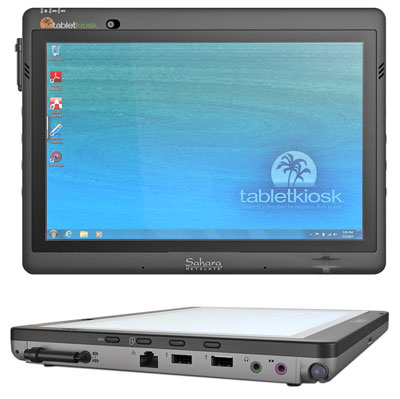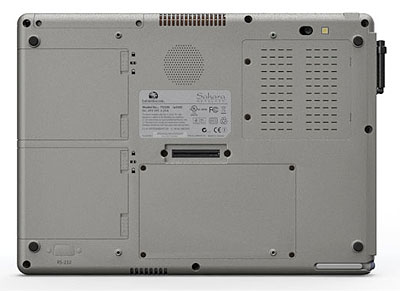On July 30, 2013, TabletKiosk announced an addition to its popular line of 12.1" enterprise-grade Tablet PCs. The new Sahara NetSlate a525, based on the dual-core Intel Atom N2800 processor, is a power-efficient solution for companies looking for a value-priced tablet with superior connectivity, full compatibility with the TabletKiosk accessory ecosystem, and a long product life cycle.

Those unfamiliar with TabletKiosk's product line-up should know that the company's 12.1-inch tablet offerings come in high-end Sahara "Slate PC" and value-priced Sahara "NetSlate" versions. Both lines use the exact same form factor and design, but while the Slate PC models use Intel Core i7 processors, the NetSlate versions are based on Intel Atom processors and related technology. This offers enterprise customers the ability to cost-efficiently deploy either high or standard performance tablets according to specific job requirements, without losing the benefit of full docking station, battery and peripherals compatibility.
The new Sahara NetSlate essentially replaces the older NetSlate a510 in TabletKiosk's lineup. What's different? On the processor side, the new a525 uses a 1.86GHz Intel Atom "Cedarview" N2800 versus the 1.8GHz Intel "Pineview" Atom D525 in the a510. While both are dual-core processors, the newer chip uses 32nm versus 45nm process technology, includes enhanced Intel SpeedStep technology, a faster GPU that's now PowerVR-based, more advanced power management, power-efficient DDR3L support, and numerous other enhancements geared towards mobile deployments. All of this results in a maximum Thermal Design Power of only 6.5 watts, just half that of the D525's 13 watts. This means less heat to dissipate, and considerably more economical operation. And, in fact, TabletKiosk claims more than three times the battery life of the predecessor model. That's huge.
Note that while the integrated graphics capabilities of Intel Atom-based systems have historically been marginal, the "Cedarview" N2600 and N2800 processors with their PowerVR-based GMA 3650 GPU are much better graphics performers. That's especially true in 3D operations and, even more so, in OpenGL performance. In the latter -- widely used in CAD, visualization and simulations -- N2800-based systems excel, cranking out numbers rivaling and beating some Intel Core-based systems. HD video encoding and decoding, likewise, are no problem.
Unlike the a510 predecessor model which didn't have any integrated cameras, the a525 has two of them. There's a 2-megapixel auto-focus webcam that can record 1600 x 1200 pixel stills and also handle 30 frames-per-second VGA video. For documentation, there's a rear-mounded 5-megapixel auto-focus camera with an LED flash that records stills up to 2,592 x 1,944 pixels and also does 720p HD video.
The new processor, of course, is only part of the story. TabletKiosk took this opportunity to improve and finetune the Sahara NetSlate not only on the CPU front, but in several other areas as well. RAM is now of the DDR3L variety at speeds up to 1066MHz, and 4GB comes standard instead of just 2GB. Standard data storage is now a 5,400rpm 320GB, with higher capacity (up to 1TB) and faster (7,200rpm) hard disks available, as well as SSD configurations starting at 80GB. The switch from Intel Centrino Advanced-N 6205 to Centrino Wireless-N 135 means dual-mode Bluetooth 4.0 is now included in the WiFi module. On the operating system side, Windows 7 Pro still comes standard, but the new tablet can also be ordered with Windows 8. On the other hand, whereas the a510 had two USB 3.0 ports, the a525 only supports USB 2.0.
As in the recently introduced i535/i575 models, TabletKiosk thought of another seemingly little thing that may well matter in many applications: optionally available in the new a525 is a true serial interface controller and DB9 serial port. What does "true" RS232 mean here? While there are USB-to-serial converters, USB and serial are inherently different in the way they provide power (USB uses +5V, serial +5V, +12V, and -12V) and that can pose problems because converters may not support the voltages properly, and/or they may also not have the proper hardware flow control for a particular serial interface application. With a true serial controller, that's never an issue.
The picture below shows the backside of the a525 with its docking connector port in the center, the dual battery compartments, and the rear-camera with its LED illuminator.

Just as important as what has changed in the new a525 is what hasn't changed. The design, form factor, and overall configuration remain the same. That means there's virtually complete backward compatibility with the significant number of older Sahara NetSlate and Sahara Slate PCs deployed out there in the enterprise. Accessories, peripherals, docks all stay the same, and nothing is obsolete. That's a BIG issue in enterprise deployments where there's nothing more annoying than to have to replace the whole ancillary infrastructure for every new model.
One area where TabletKiosk never skimped is in the display. The new a525 still uses an AFFS LCD with superior stability and horizontal/vertical viewing angles. It is large enough for real work, and its semi-matte surface makes for very little reflection. What also continues is the wide range of available touch and digitizer technologies. 5-wire resistive is standard, but projected capacitive multi-touch is available for the NetSlate as well (add US$120). Customers may also opt for a dual mode panel with an active Wacom pen and either projected capacitive touch or resistive touch (our preferred choice). And unlike is the case with many Windows tablets, there is no bulky bezel around the screen for fingers to bump into; the flush-mounted glass extends well beyond the perimeter of the LCD.
Overall, like they do with their smaller eo tablet, TabletKiosk covers a lot of ground with their newly broadened Sahara NetSlate/Slate PC platform. Not only is the Sahara available in a wide range of performance (and price) levels, but TabletKiosk future-proofs its products by upgrading them with state-of-the-art technologies as they come along.
When it comes to decisionmaking time, what are the primary differences between the high-end Slate PC and the value-priced NetSlate versions? Well, Core i7 models provide higher peak performance (we estimate TabletKiosk's Core i7-based Slate PC i575 will offer 2.5 to 3X peak performance), and they support a number of interface standards and Intel technologies not available in Atom-based models (such as USB 3.0 and DisplayPort support, and advanced Intel technologies like Intel vPro or Intel Anti-Theft). As a result, the starting price of the high-end Sahara Slate PC i575 is about 40% higher than that of the Sahara NetSlate a525.
As for NetSlate a525 pricing, the new Intel Atom N2800-based model starts at US$1,499 with 4GB RAM and a 320GB hard disk. That's very reasonable for this class of enterprise-oriented machine, and it certainly gives corporate customers additional incentive to consider this eminently rational and practical TabletKiosk platform.



